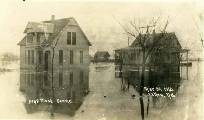Search the Blog
Categories
- Books & Reading
- Broadband Buzz
- Census
- Education & Training
- General
- Grants
- Information Resources
- Library Management
- Nebraska Center for the Book
- Nebraska Memories
- Now hiring @ your library
- Preservation
- Pretty Sweet Tech
- Programming
- Public Library Boards of Trustees
- Public Relations
- Talking Book & Braille Service (TBBS)
- Technology
- Uncategorized
- What's Up Doc / Govdocs
- Youth Services
Archives
Subscribe
Category Archives: Information Resources
NE Department of Labor Announces Library Partnership
More Nebraskans will have access to career services at local libraries thanks to a partnership between the Nebraska Department of Labor and the Nebraska Library Commission. As part of the Nebraska Library Commission’s Library Broadband Builds Nebraska Communities initiative, local libraries will be better equipped to provide customer access to resources for job hunters in the library. Library staff will be trained to assist customers in using NEworks.nebraska.gov, the NE Department of Labor self-help Website with services for Job Seekers (Find a Job, Create a Resume, etc.) and services for Employers (Find a Candidate, Post Job Openings, etc.).
Partnerships with state and local service providers are an integral component of this initiative to upgrade or install 147 computer centers in libraries across the state, which began in 2010 when the Library Commission received a $3.6 million grant through the federal American Recovery and Reinvestment Act and the Bill and Melinda Gates Foundation. Other partners that will provide services through the public computing centers include: Central Community College, Nebraska Department of Labor, Nebraska Court Administrator’s Office, Nebraska Community Foundation, Center for Rural Affairs, Center for Rural Entrepreneurship, University of Nebraska-Lincoln Extension, University of Nebraska Medical Center, McGoogan Library of Medicine, and the National Network of Libraries of Medicine.
See http://www.omaha.com/article/20120407/MONEY/704079922 for Omaha World Herald story by By Paige Yowell.
Library Broadband Builds Nebraska Communities Featured in BTOP Update
The April 2012 issue of the BTOP Update newsletter features Nebraska’s BTOP project, Library Broadband Builds Nebraska Communities. This newsletter BTOP Update Vol 3 Number 4 April 2012 provides recipients with links to news, resources, and other programmatic updates.
Rising Waters
Today is the 100th anniversary of the March 30th, 1912 flood in Valley Nebraska. This year we are experiencing one of the warmest and driest months of March on record and drought is more to be feared than flooding. But last year was a different story – mountain snowpack and torrents of rain in Montana caused the Missouri River to flood. The Valley flood a century ago is another reminder that March is indeed a lion and a lamb. The winter of 1912 must have been much colder and longer than the one we have just experienced, because the large amount of ice still on the rivers formed ice jams and caused a very destructive flood.
Valley is located between the Platte and the Elkhorn rivers. The confluence of the two rivers is several miles south of the town. This excerpt from the Norfolk weekly News-Journal, March 29, 1912, Page 8 describes conditions at Valley on Tuesday, March 26.
“A. T. Hutchinson of the A. L. Kulian Co. , returned last night from Valley , Neb. , where he attended a directors meeting of a seed house of which he is a director. Mr. Hutchinson reports that much fear is entertained at Valley and Waterloo over the flood stage of the Platte river which is thirty feet high at the narrowed channel at the Burlington bridge at Fremont. The ice is thirty-six inches thick and a gorge is forming. Blasting has been going on for a week , but it is not believed that this will save the lowlands arount Valley from a flood. The Elkhorn river, says Mr. Hutchinson, is in good shape and he can see no danger of a flood in this vicinity.”
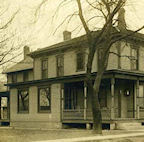 Valley Public Library has contributed a collection of photographs to Nebraska Memories depicting the town both before and after the flood. This 1910 photo of Reid’s Hotel at the corner of Front and Pine streets shows a substantial two-story building flanked by trees and paved sidewalks.
Valley Public Library has contributed a collection of photographs to Nebraska Memories depicting the town both before and after the flood. This 1910 photo of Reid’s Hotel at the corner of Front and Pine streets shows a substantial two-story building flanked by trees and paved sidewalks.
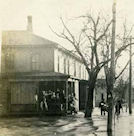 Two years later, this March 30, 1912 photo of the same corner shows that the flooding may have been even worse than Mr. Hutchinson’s comments to the newspaper suggested. Water is lapping at the foot of the front porch of the hotel and several people are standing on it surveying the flooded street. There must have been a lot of damage to the ground floor of the hotel and all the buildings on those streets. The photo description indicates that flood waters from the Platte and Elkhorn rivers merged and some areas were covered in four feet of muddy water.
Two years later, this March 30, 1912 photo of the same corner shows that the flooding may have been even worse than Mr. Hutchinson’s comments to the newspaper suggested. Water is lapping at the foot of the front porch of the hotel and several people are standing on it surveying the flooded street. There must have been a lot of damage to the ground floor of the hotel and all the buildings on those streets. The photo description indicates that flood waters from the Platte and Elkhorn rivers merged and some areas were covered in four feet of muddy water.
This photo taken in April 1912 shows damage to a wagon road near the railroad tracks. The road has eroded away and looks like a “gorge” such as Mr. Hutch inson told about. As the flood waters recede, undermined utility poles are falling over. The pole with the repair man perched on it looks like it could topple into the water at any moment–not a place I would have wanted to be! According to the photo description damages to the area were estimated at $40,000 – a hefty sum a century ago.
inson told about. As the flood waters recede, undermined utility poles are falling over. The pole with the repair man perched on it looks like it could topple into the water at any moment–not a place I would have wanted to be! According to the photo description damages to the area were estimated at $40,000 – a hefty sum a century ago.
And how would you like to be the poor people living in these homes? More photographs of the Valley flood of 1912 can be viewed in Nebraska Memories.
Visit Nebraska Memories to search for or browse through many more historical images digitized from photographs, negatives, postcards, maps, lantern slides, books and other materials.
Nebraska Memories is a cooperative project to digitize Nebraska-related historical and cultural heritage materials and make them available to researchers of all ages via the Internet. NebraskaMemories is brought to you by the Nebraska Library Commission. If your institution is interested in participating in Nebraska Memories, see http://nlc.nebraska.gov/nebraskamemories/participation.aspx for more information, or contact Beth Goble, Government Information Services Director, or Devra Dragos, Technology & Access Services Director.
The Faces of 1940
 As many of you may know 1940 is an important year to genealogists and historians right now. On April 2, 2012 at 9 AM EDT the U.S. National Archives and Records Administration will make the 1940 Census available to the public online. This is the first time the 1940 Census can be made available because of the 72-year rule. This rule basically states that the U.S. government cannot release personally identifiable information about a person until 72 years after it’s been collected.
As many of you may know 1940 is an important year to genealogists and historians right now. On April 2, 2012 at 9 AM EDT the U.S. National Archives and Records Administration will make the 1940 Census available to the public online. This is the first time the 1940 Census can be made available because of the 72-year rule. This rule basically states that the U.S. government cannot release personally identifiable information about a person until 72 years after it’s been collected.
 As some of us anxiously wait for April 2 I thought it would be fun to look at the faces of people from 1940 as documented in Nebraska Memories. To start
As some of us anxiously wait for April 2 I thought it would be fun to look at the faces of people from 1940 as documented in Nebraska Memories. To start ![]() off the year it appears they had more snow in the early months of 1940 then we did this year. A photo from January 1940 shows a large group of children bundled in their winter coats sitting and in the back of a pickup truck on a snow covered road. Another photo from February shows a boy outside in his coat and hat shoveling snow.
off the year it appears they had more snow in the early months of 1940 then we did this year. A photo from January 1940 shows a large group of children bundled in their winter coats sitting and in the back of a pickup truck on a snow covered road. Another photo from February shows a boy outside in his coat and hat shoveling snow.
 Photos taken in March of 1940 give us a glimpse of the workers at the Falstaff Brewery. The brewery was located at 25th and Vinton in Omaha. In contrast to the brewery works dressed in overalls most of the business men of Bertrand and
Photos taken in March of 1940 give us a glimpse of the workers at the Falstaff Brewery. The brewery was located at 25th and Vinton in Omaha. In contrast to the brewery works dressed in overalls most of the business men of Bertrand and  Loomis are pictured wearing ties with jackets or vests. According to the note this group of businessmen was on an outing to the Central Nebraska Public Power and Irrigation District.
Loomis are pictured wearing ties with jackets or vests. According to the note this group of businessmen was on an outing to the Central Nebraska Public Power and Irrigation District.  The 10th grade class of Bruno High School got their picture taken on April 30, 1940. The four young men in the class look dashing in their dark suites.
The 10th grade class of Bruno High School got their picture taken on April 30, 1940. The four young men in the class look dashing in their dark suites.
 The latter half of 1940 appeared to be the time for fun just by looking at the photos in Nebraska Memories. I have no idea who George Turner was but it sure looks like he knew how to through a party. One photo from the party shows a number of party goers proudly holding up their mugs of beer. I have to wonder if it’s Falstaff beer. The party goers even had a mock shotgun wedding at the party.
The latter half of 1940 appeared to be the time for fun just by looking at the photos in Nebraska Memories. I have no idea who George Turner was but it sure looks like he knew how to through a party. One photo from the party shows a number of party goers proudly holding up their mugs of beer. I have to wonder if it’s Falstaff beer. The party goers even had a mock shotgun wedding at the party.
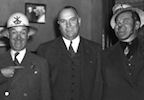 The other fun event documented was Laurel and Hardy appearing in person at the Orpheum Theatre in October of 1940. I bet that would have been a fun show to attend.
The other fun event documented was Laurel and Hardy appearing in person at the Orpheum Theatre in October of 1940. I bet that would have been a fun show to attend.
 I hope you enjoyed looking at some of the faces of 1940 as you wait to view the 1940 Census. You can learn more about the 1940 Census by visiting the National Archives 1940 Census website. If you’ve never explored a historic U.S. Census Nebraskan’s have access to the 1790-1930 Census through the HeritageQuest Online databases. This database is made available at no cost to all Nebraskans through NebraskAccess.
I hope you enjoyed looking at some of the faces of 1940 as you wait to view the 1940 Census. You can learn more about the 1940 Census by visiting the National Archives 1940 Census website. If you’ve never explored a historic U.S. Census Nebraskan’s have access to the 1790-1930 Census through the HeritageQuest Online databases. This database is made available at no cost to all Nebraskans through NebraskAccess.
Visit Nebraska Memories to search for or browse through many more historical images digitized from photographs, negatives, postcards, maps, lantern slides, books and other materials.
Nebraska Memories is a cooperative project to digitize Nebraska-related historical and cultural heritage materials and make them available to researchers of all ages via the Internet. Nebraska Memories is brought to you by the Nebraska Library Commission. If your institution is interested in participating in Nebraska Memories, see http://nlc.nebraska.gov/nebraskamemories/participation.aspx for more information, or contact Beth Goble, Government Information Services Director, or Devra Dragos, Technology & Access Services Director.
Memories is brought to you by the Nebraska Library Commission. If your institution is interested in participating in Nebraska Memories, see http://nlc.nebraska.gov/nebraskamemories/participation.aspx for more information, or contact Beth Goble, Government Information Services Director, or Devra Dragos, Technology & Access Services Director.
ProQuest Will Publish the Statistical Abstract
ProQuest announced today that the company will publish the Statistical Abstract of the United States in both print and digital formats. The U.S. Census Bureau, which had published the annual resource, decided earlier this year to cease publication after 2012. The Statistical Abstract has been produced since 1878. The ProQuest announcement includes more details.
The 1940 Census is Coming!
The Lincoln-Lancaster County Genealogical Society and Nebraska State Historical Society are sponsoring a special event to celebrate the the long-awaited release of the 1940 Census. It will be held Sunday, March 25, 2012 at 1:30 pm at Bess Dodson Walt Branch Library , 6701 South 14 th Street, Lincoln, NE.
The program is free, and will feature 1940 exhibits, music and memorabilia and a special presentation by Lori Cox-Paul, Director of Archival Operations, National Archives at Kansas City entitled “Introduction to the 1940 Census”.
The 1940 Census will be released digitally on April 2, 2012.
For more information about the celebration contact
jcook2@neb.rr.com
402-483-1239
NCompass Live: Finding the Good Stuff – Recorded Online Session
![]() How do you keep up? There’s so much to read, and so little time. How do you find the information that’s important to you and winnow out all the stuff that’s not urgent or important or pertinent? Michael Sauers, Christa Burns, and Laura Johnson will start a discussion about what they’re reading and encourage participants to join in, as together we discover the best places to find information.
How do you keep up? There’s so much to read, and so little time. How do you find the information that’s important to you and winnow out all the stuff that’s not urgent or important or pertinent? Michael Sauers, Christa Burns, and Laura Johnson will start a discussion about what they’re reading and encourage participants to join in, as together we discover the best places to find information.
Download audio (MP3)
Subscribe via RSS
Subscribe via iTunes
Video (YouTube)
Presentation Slides (SlideShare)
Links
(Delicious)
Posted in Information Resources
Leave a comment
NCompass Live: American FactFinder: the Census Bureau’s online data retrieval tool – Recorded Online Session
![]() This session will show you how to navigate the Census Bureau online data portal called American FactFinder. The system has recently been totally redesigned and has several new features. We’ll give you tips and shortcuts for obtaining the data you need. American FactFinder is the key place to retrieve information from the 2010 and 2000 Censuses, annual socio-economic data from the American Community Survey, and a variety of other commonly used Census data sources. Presenter: David Drozd, Research Coordinator, Center for Public Affairs Research (CPAR), Nebraska State Data Center.
This session will show you how to navigate the Census Bureau online data portal called American FactFinder. The system has recently been totally redesigned and has several new features. We’ll give you tips and shortcuts for obtaining the data you need. American FactFinder is the key place to retrieve information from the 2010 and 2000 Censuses, annual socio-economic data from the American Community Survey, and a variety of other commonly used Census data sources. Presenter: David Drozd, Research Coordinator, Center for Public Affairs Research (CPAR), Nebraska State Data Center.
http://nlc.nebraska.gov/nlcpodcast/player.swf
Download audio (MP3)
Subscribe via RSS
Subscribe via iTunes
Video (YouTube)
Presentation Slides (SlideShare)
Links
(Delicious)
Posted in Census, Education & Training, Information Resources, What's Up Doc / Govdocs
Tagged census
Leave a comment
Encyclopedia Britannica No Longer a Print Resource
A moment of silence! The 2010 edition of the venerable Encyclopedia Britannica (first published in 1768) will be the last to be available in print. The company will now focus on its online encyclopedias and curricula for schools. Read more in the New York Times. (seen in PW Daily.)
Posted in Information Resources
Leave a comment
Music in Our Schools
It recently came to my attention that March is Music in Our Schools Month, a month dedicated to advocacy in favor of music education programs in schools. If you explore Nebraska Memories, you can see many images of Nebraska’s students enjoying music in their schools.
 Nebraska’s schools provided opportunities for vocal music, as shown in this photograph of the Irving Junior High boys choir in Lincoln. Students also had chances to
Nebraska’s schools provided opportunities for vocal music, as shown in this photograph of the Irving Junior High boys choir in Lincoln. Students also had chances to participate in instrumental music, as shown by the North High School orchestra in Omaha or the band at the Girls’ Industrial School in Geneva.
participate in instrumental music, as shown by the North High School orchestra in Omaha or the band at the Girls’ Industrial School in Geneva.
 The Polley Music Library collection also includes a number of programs from musical events featuring students. These events include such concerts as those sponsored by the Nebraska Music Teachers Association, as well as Nebraska All State musical concerts.
The Polley Music Library collection also includes a number of programs from musical events featuring students. These events include such concerts as those sponsored by the Nebraska Music Teachers Association, as well as Nebraska All State musical concerts.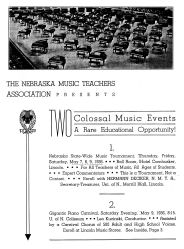
Visit Nebraska Memories to search for or browse through many more historical images digitized from photographs, negatives, postcards, maps, lantern slides, books and other materials.
Nebraska Memories is a cooperative project to digitize Nebraska-related historical and cultural heritage materials and make them available to researchers of all ages via the Internet. Nebraska Memories is brought to you by the Nebraska Library Commission. If your institution is interested in participating in Nebraska Memories, see http://nlc.nebraska.gov/nebraskamemories/participation.aspx for more information, or contact Beth Goble, Government Information Services Director, or Devra Dragos, Technology & Access Services Director.
Taking a Stroll
 … down Memory Lane, er, Main Street. Before suburbs and big box stores, the main street was the heart of many towns. Out on the plains, main streets in many small towns probably began looking something like Crawford’s does in this image from the Crawford Historical Society and Museum Collection. Not enough traffic to keep down the weeds yet, and wooden buildings under construction.
… down Memory Lane, er, Main Street. Before suburbs and big box stores, the main street was the heart of many towns. Out on the plains, main streets in many small towns probably began looking something like Crawford’s does in this image from the Crawford Historical Society and Museum Collection. Not enough traffic to keep down the weeds yet, and wooden buildings under construction.
 In towns that had been established for a little longer, the main streets became hardened dirt—unless there was enough rain to turn it into mud. And while there is still space between the wooden structures on Sacramento’s main street, progress can be seen in the signage on the buildings and the number of people in the picture. Image from the Phelps County Historical Society Collection.
In towns that had been established for a little longer, the main streets became hardened dirt—unless there was enough rain to turn it into mud. And while there is still space between the wooden structures on Sacramento’s main street, progress can be seen in the signage on the buildings and the number of people in the picture. Image from the Phelps County Historical Society Collection.
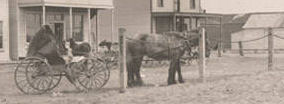 As more businesses and government buildings went up, amenities such as hitching posts became necessary. In this image of Ericson from the Nebraska State Historical Society Collection, between the stores on one side of Main Street and the Post Office on the other a rope has been strung along several posts for wagon parking down the middle of the street. Notice that the buildings are all wooden structures.
As more businesses and government buildings went up, amenities such as hitching posts became necessary. In this image of Ericson from the Nebraska State Historical Society Collection, between the stores on one side of Main Street and the Post Office on the other a rope has been strung along several posts for wagon parking down the middle of the street. Notice that the buildings are all wooden structures.
 Modern inventions like electricity and the telephone brought poles and wires to town. This image of Eagle’s Main Street shows poles down both sides of the street where it looks like paring for wagons and buggies is limited mostly to the west side of the street—or one business is really popular! Note that there is one brick building on the right-side of the street. This image is from the Jane Pope Geske Heritage Room of Nebraska Authors Collection.
Modern inventions like electricity and the telephone brought poles and wires to town. This image of Eagle’s Main Street shows poles down both sides of the street where it looks like paring for wagons and buggies is limited mostly to the west side of the street—or one business is really popular! Note that there is one brick building on the right-side of the street. This image is from the Jane Pope Geske Heritage Room of Nebraska Authors Collection.
 By the 1930s most poles and lines have been banished to the alleys. And as seen on Fairmont’s Main Street, street lights have been installed in front of brick buildings. Hitching posts have disappeared and no parking meters have appeared as yet in this image from the Fairmont Public Library/Fillmore County Historical Society Collection.
By the 1930s most poles and lines have been banished to the alleys. And as seen on Fairmont’s Main Street, street lights have been installed in front of brick buildings. Hitching posts have disappeared and no parking meters have appeared as yet in this image from the Fairmont Public Library/Fillmore County Historical Society Collection.
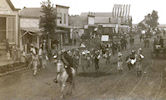 And over the years, big events in town took place on Main Street, like Fourth of July parades, political speeches, and the Calathumpian Parade shown here in Fremont. This image is part of the Keene Memorial Library Collection.
And over the years, big events in town took place on Main Street, like Fourth of July parades, political speeches, and the Calathumpian Parade shown here in Fremont. This image is part of the Keene Memorial Library Collection.
Visit Nebraska Memories to search for or browse through many more historical images digitized from photographs, negatives, postcards, maps, lantern slides, books and other materials.
Nebraska Memories is a cooperative project to digitize Nebraska-related historical and cultural heritage materials and make them available to researchers of all ages via the Internet. Nebraska Memories is brought to you by the Nebraska Library Commission. If your institution is interested in participating in Nebraska Memories, see http://nlc.nebraska.gov/nebraskamemories/participation.aspx for more information, or contact Beth Goble, Government Information Services Director, or Devra Dragos, Technology & Access Services Director.
NCompass Live: Learning to Live Without a Statistical Abstract – Recorded Online Session
![]() In March 2011, the division of the U.S. Census Bureau responsible for data compilations such as the Statistical Abstract of the United States revealed that it would discontinue several popular publications. The decision was largely driven by budgetary concerns, but it also reflected further evolution toward new vectors for distributing data electronically. James Shaw, Director of Collections, Criss Library – UNO, will provide an update of the situation and offer practical advice concerning alternative resources. He will also explore the policy implications of trading away convenience and ease-of-use for enhanced data tools more suitable for advanced researchers than the general public.
In March 2011, the division of the U.S. Census Bureau responsible for data compilations such as the Statistical Abstract of the United States revealed that it would discontinue several popular publications. The decision was largely driven by budgetary concerns, but it also reflected further evolution toward new vectors for distributing data electronically. James Shaw, Director of Collections, Criss Library – UNO, will provide an update of the situation and offer practical advice concerning alternative resources. He will also explore the policy implications of trading away convenience and ease-of-use for enhanced data tools more suitable for advanced researchers than the general public.
Download audio (MP3)
Subscribe via RSS
Subscribe via iTunes
Video (YouTube)
Presentation Slides (SlideShare)
Links (Delicious)
Generous Nebraska Libraries Support Book Clubs
Interlibrary Loan isn’t the ONLY way that our libraries share materials with each other. Through the Nebraska Book Club Kits Sharing Wiki, libraries list and share their book club kits with others in the state. Many thanks to the following for listing and sharing their kits with others: Crete Public Library, Hastings Public Library, John Stahl Library (West Point), Keene Memorial Library (Fremont), Northeast Library System (Columbus), Oakland Public Library, Southeast Library System (Lincoln), and the Wayne Public Library. If your library has book club kits and would like to add them to our wiki, contact Lisa Kelly for the password.
The Nebraska Library Commission now has over 250 book club kits to check out and share with you as well. Please contact us to inquire or check out any of our kits or fill out our new and improved request form to reserve a kit.
Posted in Books & Reading, General, Information Resources
Leave a comment
Database Trial: World Almanac Online and World Almanac for Kids Online
Infobase Learning, in conjunction with the Nebraska Library Commission, is offering trial access to the following two K-12 school products: The World Almanac Online and The World Almanac for Kids Online.
- World Almanac Online provides students and researchers access to authoritative, essential statistics on hundreds of topics in a searchable online format. Learn more!
- World Almanac for Kids Online expands on the contents of the World Almanac for Kids print edition, along with other award-winning reference books from World Almanac, Chelsea House, and Facts on File. A natural complement to the curriculum, each subject area provides resources for homework, reports, and projects. Kids can explore grade-appropriate topics while developing online research skills with a trusted content source. Learn more!
Trial URL: http://online.infobaselearning.com/Direct.aspx?aid=105792&pid=WE00
Trial Dates: February 2, 2012 through March 2, 2012
Trial Access Instructions: The trial username and password were distributed via a February 3, 2012 message to the TRIAL mailing list. Nebraska librarians who didn’t receive this information or would like to have it sent to them again may contact Susan Knisely.
Posted in Information Resources, Uncategorized
Leave a comment
Access Video On Demand Trial
Infobase Learning, in conjunction with the Nebraska Library Commission, is offering trial access to their public library streaming video service, Access Video On Demand, from February 2 through March 2.
Description: Access Video On Demand is a streaming video service for public libraries. It offers thousands of exclusive educational videos from top producers with unlimited, simultaneous usage, 24/7. Access Video On Demand features nine streaming collections, which can be purchased individually or as a bundle. Learn more online!
Trial URL: http://online.infobaselearning.com/Direct.aspx?aid=105791&pid=WE00
Trial Access Instructions: The trial username and password were distributed via a February 3 message to the TRIAL mailing list. Nebraska librarians who didn’t receive this information or would like to have it sent to them again may contact Susan Knisely.
Posted in Information Resources
Leave a comment
We Really are Living Longer
You may have seen recent news reports about the drop in fatal automobile accidents in Nebraska to the lowest level since 1944. Other causes of death, including homicide, have dropped too. The latest mortality report from the National Center for Health Statistics, Deaths, Preliminary Data for 2010 provides a wealth of information about what we are dying of and how long we live. Life expectancy increased from 78.6 in 2009 to 78.7 in 2010. Interestingly, Hispanics live the longest (83.8 years for females, 78.8 for males). The CDC/NCHS site is a wonderful source of informaton that even has a for librarians section. The leading causes of death are
Diseases of the heart
Malignant neoplasms
Chronic lower respiratory diseases
Cerebrovascular diseases
Accidents (unintentional injuries)
Alzheimer’s disease
Diabetes mellitus
Looking at this list reminds me that although death comes to all of us, lifestyle can affect the length and quality of life. I’m planning to eat more fish, exercise more, and buckle up every time I get into the car.
Digital Encyclopedia of the Great Plains is Online
The University of Nebraska-Lincoln has launched an incredible resource online: the Digital Encyclopedia of the Great Plains. We have it linked from this part of our NebraskAccess website.
With 1,316 entries contributed by more than one thousand scholars, this groundbreaking reference work captures what is vital and interesting about the Great Plains—from its temperamental climate to its images and icons, its historical character, its folklore, and its politics.
The Great Plains is a vast expanse of glasslands stretching from the Rocky Mountains to the Missouri River and from the Rio Grande to the coniferous forests of Canada—an area more than eighteen hundred miles from north to south and more than five hundred miles from east to west. The Great Plains region includes all or parts of Texas, New Mexico, Oklahoma, Kansas, Colorado, Nebraska, Wyoming, South Dakota, North Dakota, Montana, Alberta, Saskatchewan, and Manitoba. The region, once labeled “the Great American Desert,” is now more often called the “heartland,” or, sometimes, “the breadbasket of the world.” Its immense distances, flowing grasslands, sparse population, enveloping horizons, and dominating sky convey a sense of expansiveness, even emptiness or loneliness, a reaction to too much space and one’s own meager presence in it.
The Plains region is the home of the Dust Bowl, the massacre at Wounded Knee, the North-West Rebellion, the Tulsa race riot, the Lincoln County War, the purported Roswell alien landing, and the Sturgis Motorcycle Rally. Its products have included furs, cattle, corn, wheat, oil, gas, and coal as well as jazz, literature, and political reform. It has been inhabited for more than twelve thousand years, since Paleo-Indians hunted mammoth and bison. More recent emigrants came from eastern North America, Europe, Latin America, and Asia, resulting in a complex and distinctive ethnic mosaic.
Posted in General, Information Resources
Leave a comment
Four-Star Accommodations
If you traveled during the holiday season this year, perhaps your home-away-from-home was a hotel. Compare your experiences to these images of hotels from Nebraska Memories.
 Hotels in Nebraska have ranged from imposing structures, like the Blackstone Hotel in Omaha or the Ruwe Hotel in Fremont, to smaller establishments, like Wilcox House in Papillion or the Talbot Hotel in Brainard.
Hotels in Nebraska have ranged from imposing structures, like the Blackstone Hotel in Omaha or the Ruwe Hotel in Fremont, to smaller establishments, like Wilcox House in Papillion or the Talbot Hotel in Brainard.
Nebraska Memories features views of the interiors of hotels as well. Take a glimpse inside 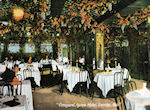 some hotel lobbies, like those at the Hotel Loyal in Omaha or the Perkins Hotel in David City. Some hotels had places to eat inside, like the Vineyard Cafe at the Rome Hotel in Omaha, or the dining room at the Zeeck Hotel in Papillion.
some hotel lobbies, like those at the Hotel Loyal in Omaha or the Perkins Hotel in David City. Some hotels had places to eat inside, like the Vineyard Cafe at the Rome Hotel in Omaha, or the dining room at the Zeeck Hotel in Papillion.
If motels and motor courts are more your style, check out the ![]() Lone Pine Court and Filling Station or Sunnyside Cottages, both located in Sidney.
Lone Pine Court and Filling Station or Sunnyside Cottages, both located in Sidney.
Visit Nebraska Memories to search for or browse through many more historical images digitized from photographs, negatives, postcards, maps, lantern slides, books and other materials.
Nebraska Memories is a cooperative project to digitize Nebraska-related historical and cultural heritage materials and make them available to researchers of all ages via the Internet. Nebraska Memories is brought to you by the Nebraska Library Commission. If your institution is interested in participating in Nebraska Memories, see http://nlc.nebraska.gov/nebraskamemories/participation.aspx for more information, or contact Beth Goble, Government Information Services Director, or Devra Dragos, Technology & Access Services Director.
A Julie of all Trades
The month of December can be difficult with long to do lists and sentimental hurdles. I spent this December considering the loss of a very fine colleague – Julie Pinnell – who will leave the Library Commission on January 3rd after nearly 17 years of service to become the Director of the Doane College Library. For me, this will be a difficult transition as Julie knows a little bit about all things library – from technical to public services and a little bit of everything in between. In addition, she has been the person with whom I have considered ideas and enjoyed many a cup of coffee with in every kind of weather and budgetary season. I will miss Julie more than I can convey, but as a Doane College graduate, I know she will do great things for Perkins Library and take very good care of the staff there, including my own beloved niece who is a student worker. I know many of you will miss hearing Julie’s voice on the phone and her wonderful workshops. There isn’t any way to replace her skills and knowledge, but at least she remains in the state of Nebraska where we’ll see her from time to time. The reference staff will forge along and keep in touch with Julie. I know those of you who will miss her will find a way to keep her in your lives as well.
Posted in General, Information Resources
Leave a comment
Say Cheese
I spent a bit of time over the holiday weekend telling family members to smile and say cheese. As usual some of them were more cooperative then others. The other day, as I was looking at the photos I took, I wondered if there were any interesting Christmas photos in Nebraska Memories and I’m happy to report I wasn’t disappointed. Here are a few of my favorites.
 My favorite Christmas picture has to be the photo titled “Family by Christmas tree“. Unfortunately we don’t know the name of the family featured in this photo from the early 1900’s but the looks on their faces are priceless. As the description states none of the six people in the photo are looking in the same direction. In some ways it is a typical family photo however with two of the boys messing around, the third one facing the wrong direction and the fourth one looking very unhappy. Thankfully I don’t think any of my family photos turned out quite this bad. The lack of names on this photo however does serve as a good reminder. I need to take the time to add names to all of my family photos so a hundred plus years from now folks will know the names of everyone in the photo including the person who was making bunny ears.
My favorite Christmas picture has to be the photo titled “Family by Christmas tree“. Unfortunately we don’t know the name of the family featured in this photo from the early 1900’s but the looks on their faces are priceless. As the description states none of the six people in the photo are looking in the same direction. In some ways it is a typical family photo however with two of the boys messing around, the third one facing the wrong direction and the fourth one looking very unhappy. Thankfully I don’t think any of my family photos turned out quite this bad. The lack of names on this photo however does serve as a good reminder. I need to take the time to add names to all of my family photos so a hundred plus years from now folks will know the names of everyone in the photo including the person who was making bunny ears.
 I really have to admire the photographer, children and anyone who helped with this photo of the “Immanuel Children’s Home at Christmas“. Somehow they managed to get eight small children to sit facing the camera, have fairly happy looks on their faces, stop playing with their toys, and hold still long enough to snap a photo. I find that pretty impressive! It’s also a cute picture.
I really have to admire the photographer, children and anyone who helped with this photo of the “Immanuel Children’s Home at Christmas“. Somehow they managed to get eight small children to sit facing the camera, have fairly happy looks on their faces, stop playing with their toys, and hold still long enough to snap a photo. I find that pretty impressive! It’s also a cute picture.
 I also enjoyed looking at all of the Christmas trees in the different photos. Some of them are pretty scraggly compared to the artificial trees I’m used to seeing today. And finally what would a set of Christmas pictures be without a picture of Santa Claus with his sleigh and reindeer.
I also enjoyed looking at all of the Christmas trees in the different photos. Some of them are pretty scraggly compared to the artificial trees I’m used to seeing today. And finally what would a set of Christmas pictures be without a picture of Santa Claus with his sleigh and reindeer.
Visit Nebraska Memories to search for or browse through many more historical images digitized from photographs, negatives, postcards, maps, lantern slides, books and other materials.
Nebraska Memories is a cooperative project to digitize Nebraska-related historical and cultural heritage materials and make them available to researchers of all ages via the Internet. Nebraska Memories is brought to you by the Nebraska Library Commission. If your institution is interested in participating in Nebraska Memories, see http://nlc.nebraska.gov/nebraskamemories/participation.aspx for more information, or contact Beth Goble, Government Information Services Director, or Devra Dragos, Technology & Access Services Director.
